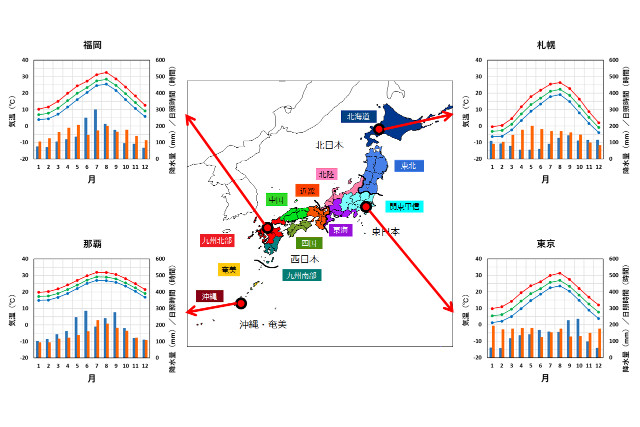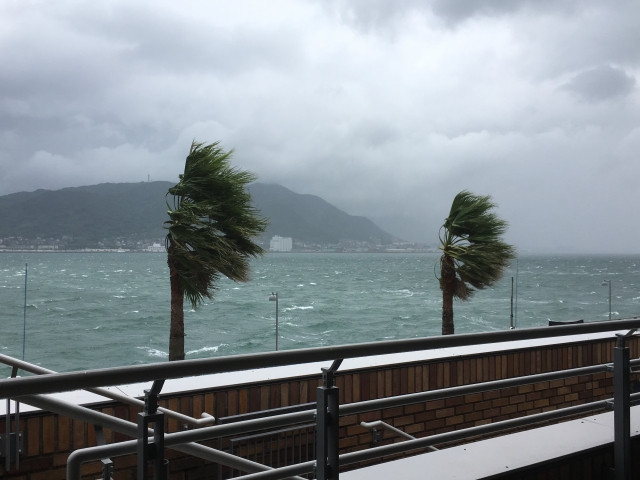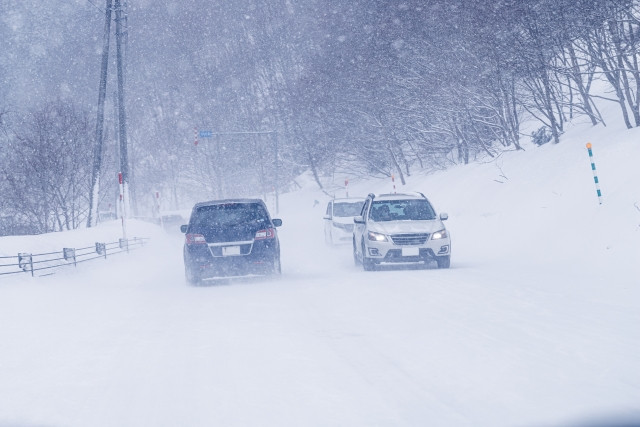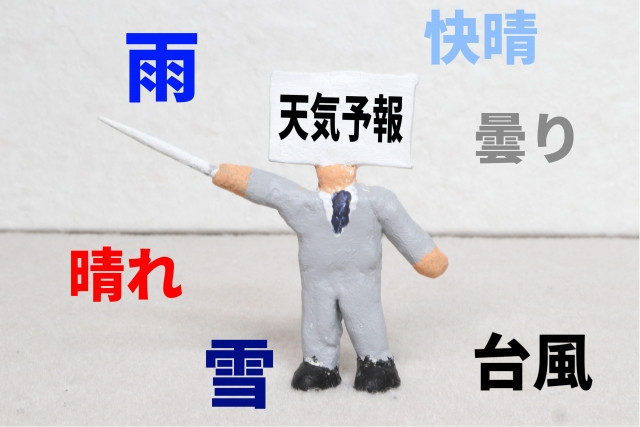“What is Japan’s climate and weather like?” or “What do I need to look out for in each season?” some people may wonder. Japan is a large country with different climate zones in some regions. The temperature and weather can vary greatly depending on the region and season, and there are things to look out for in each season, such as heatstroke, typhoons, and snow.
In this article, we summarize Japan’s climate and weather characteristics for each season, as well as points to be aware of when visiting or living in Japan.
Table of Contents
- Japan’s Climate and Weather
- What to Look Out for in Each Season
- Japanese Weather Forecast is Very Detailed
- Japanese Vocabulary Used in Weather Forecasts
- Summary
Japan’s Climate and Weather

Climate (気候 kihou) refers to the atmospheric characteristics observed in a region over many years. Specifically, it refers to phenomena such as sunny or cloudy weather, and factors such as temperature and precipitation. Weather (天気 tenki), on the other hand, a term that is often used interchangeably with climate, refers to the atmospheric state over a period of 1~3 days.
Japan is made up of a long piece of land that stretches from north to south. The climate from the north to south is different. North Japan has a subarctic climate, and the south a subtropical climate. Additionally, the west and east side also experiences different climates due to the mountain ranges that extend from east to west that block the seasonal winds (季節風 kisetsufuu). The West side faces the Sea of Japan, and the East side faces the Pacific Ocean.
To add to all that, due to the existence of 4 seasons in Japan, the temperature and precipitation levels vary throughout the year even within the same region.
Whether you are living in Japan or visiting Japan from abroad, it is important to check the weather for the next day or right before going out to check what you will need to wear or prepare for rain.

Image Credit: JMA
Japan Weather in Spring
Spring is from March to May in Japan. Spring in Japan is refreshing and pleasant with many sunny days. Note, however, that March mornings and evenings can get cold. There are also regional differences:
-
East Japan / Pacific Ocean side : higher temperature due to warm air from the south
-
West Japan / Sea of Japan side : lower temperature due to cold air from the north
Whereas, in Okinawa and the Amami Islands, May is when the rainy season (梅雨 tsuyu).
Japan Weather in Summer
Summer is from June to August in Japan. From June to mid-July is the rainy season (梅雨 tsuyu), there are many rainy, cloudy and humid days due to the influence of the seasonal rain front. Hokkaido, which is unaffected by the seasonal rain front, does not experience much rain.
Once the rainy season is over, the number of clear weather days increases across Japan. After several days of nice sunny cool days, is when the intense heat of summer sets in. Summer weather in Japan is characterized by many days when the temperature exceeds 30°C/86°F and high humidity.
In Japan, evening showers called「夕立ち yudachi」often falls in the summer evenings. Summer is also the season when typhoons often occur.
Japan Weather in Autumn
Autumn is from September to November in Japan. Like spring, September and October are sunny and pleasant days. At times however, September can bring typhoons and there may be lingering heat from summer, so take care of your physical health. In November, the number of rainy days increases on the West Japan/Sea of Japan side, and it sometimes snows in the northern regions. Even in other regions, there are days when the temperature suddenly dives and it becomes really cold, so some caution is required.
Japan Weather in Winter
Winter is from December to February in Japan, these are the coldest months of the year.
-
West Japan / Sea of Japan side : many snowy days as cold monsoon winds blowing in from the northwest hits the mountain ranges and forms clouds
-
East Japan / Pacific Ocean side : many sunny days, not much or no snow
However, due to the long north-to-south topography of the Japanese archipelago, the temperatures can vary greatly from region to region. Hokkaido and the Tohoku region in the north have many days with temperatures below 0°C/32°F. The south Okinawa and Amami Islands in the meanwhile will have an average temperature above 17°C/63°F.
※ Japan Meteorological Agency (JMA), “日本の気候” “日本の天候の概説” “平年値(年・月ごとの値)”
Writer's Pick
What to Look Out For in Japan’s 4 Seasons
Japan experiences the four seasons very distinctly. Of course, each season has its own beauty and enjoying the four seasons in Japan is on the bucket list of many Japan enthusiasts, but there are also not so nice things to look out for such as hay fever, heat stroke and typhoons.
Hay Fever in Spring

Pollen flies around Japan all year round, but especially so in spring when the number of people suffering from hay fever (花粉症 kafunshou) caused by cedar and cypress pollen increases. Weather conditions that cause the increase in the amount of scattered pollen include sunny or cloudy days, low humidity, and strong winds, which are classic signs of spring weather.
People who suffer from hay fever should wear masks and glasses when going out on days that meet those conditions. It is also a good idea to visit an ENT doctor before spring and get a prescription for medication to control hay fever symptoms. And yes, the ENT doctor becomes especially busy during and when approaching hay fever season.
Heat Stroke in Summer

Heat stroke precautions are essential in summer when the temperature and humidity is high. Heat stroke (熱中症 necchuushou) is a general term for a range of symptoms that manifests when the body suffers loss of fluid and minerals, and rise in body temperature. Specifically, dizziness, headache, and nausea may occur, and in severe cases, people may lose consciousness. Summer in Japan is not just hot but also very humid, so it is easy for heat to build up inside the body which makes it easier to get heat stroke.
On particularly hot days, avoid outdoor activities and avoid poorly ventilated areas. If you do go out, it is recommended that you avoid going out between noon and 15:00 when the temperature rises the most during the day. Use a parasol or hat to avoid direct sunlight, and drink water frequently.
Typhoons are Common in Summer and Early Autumn

In summer and the beginning of autumn are periods when typhoons frequently approach or make landfall in Japan. Approaching typhoons bring heavy rain and wind storms which can damage buildings and disrupt transportation services. The south-west of the Pacific coast is particularly prone to typhoons, so care should be taken when visiting in summer. Areas near water may also experience flooding. If you live in a flood hazard zone, you may need to evacuate so learn your evacuation route and shelter in advance.
For more about typhoons in Japan, and what to do in the case of a typhoon, read Understanding the Tumultuous Typhoons in Japan.
Severe Cold and Heavy Snow in Japan

When visiting the northern and mountainous regions in Japan during winter, be careful of the severe cold and heavy snowfall. Some areas in Japan experience the highest snowfalls in the world. In the past, Aomori Prefecture recorded 566 cm of snow, Niigata Prefecture 463 cm, and Hokkaido 342 cm.
In areas with heavy snowfall, roads can become blocked by snow, causing traffic jams and accidents involving vehicles skidding. If you do not have experience driving in snowy weather, it is not recommended to do so. Even if you are not in the north, mountain basins tend to get cold during winter so bring warm clothing.
Winter is also the influenza season in Japan. Many people take influenza vaccinations before winter, in the autumn month of November in preparation. To prevent influenza, keep warm and wear masks in crowded places.
※ JMA, “歴代全国ランキング”
Japanese Weather Forecast is Very Detailed

In Japan, the weather forecast informs not only about the atmospheric conditions (sunny/cloudy/rain, precipitation, humidity), but also important information in conjunction with the season. For example how much pollen is in the air during spring, and heat stroke warning in summer.
Other important warnings are those for typhoons, heavy rain and strong wind. In recent years, heavy rain has caused an increasing number of damage in Japan, such as flooding of buildings and suspension of transportation services. Check the weather forecast to avoid danger.
Japanese Vocabulary Used in Weather Forecasts

Weather apps are convenient for checking the weather forecast. Weather forecasts for the day or the next 3 days are also commonly played on trains in Japan. It would be helpful to know some Japanese vocabulary used in weather forecasts to understand them, which is why we have compiled some common ones to help you understand Japanese weather forecasts.
Japanese Weather Forecast Vocabulary
- 天気予報 / tenki yohou : Weather Forecast
- 気温 / kion : Temperature
- 最低気温 / saitei kion : Minimum Temperature
- 最高気温 / saikou kion : Maximum Temperature
- 湿度 / shitsudo : Humidity
- 湿気 / shikke : Dampness
- 気圧 / kiatsu : Atmospheric Pressure
- 乾燥 / kansou : Dryness
- 季節 / kisetsu : Season
- 四季 / shiki : Four Seasons
Japanese Weather Status Vocabulary
- 晴れ / hare : Clear Weather
- 快晴 / kaisei : Fine Weather
- 曇り / kumori : Cloudy Weather
- 雨 / ame : Rain
- 小雨 / kosame : Drizzle
- 大雨 / ooame : Heavy Rain
- 豪雨 / gouu : Downpour
- 雷 / kaminari : Thunder
- 霧 / kiri : Fog
- 風 / kaze : Wind
- 強風 / kyoufuu : Strong Wind
Japanese Seasonal Weather Vocabulary
- 雪 / yuki : Snow
- 大雪 / ooyuki : Heavy Snow
- 梅雨 / tsuyu : Rainy Season
- 梅雨入り / tsuyu iri : Entering the Rainy Season
- 梅雨開け / tsuyu ake : Ending of Rainy Season
- 台風 / taifuu : Typhoon
- 洪水 / kouzui : Flood
And, if you want to say that "the weather forecast is accurate" in Japanese,
天気予報が当たる
tenki yohou ga ataru
Summary

The climate in Japan varies greatly from region to region due to the country’s topography. Throughout the year, the temperature and rainfall fluctuates greatly, and each season has its own characteristics. Things to look out for include heatstroke, snowfall, typhoon, and hay fever.
Whether it is living in Japan or visiting Japan, it is important to know the climate and weather to be prepared.



































